Guppy fish are a popular choice for many aquarium enthusiasts due to their vibrant colors, playful personalities, and ease of care. As a longtime guppy owner, I have learned that providing proper care is essential for these small but resilient fish to thrive. In this article, we will cover everything you need to know about guppy fish care, from setting up the perfect tank to maintaining the ideal water conditions.
Guppy fish require a clean and spacious tank, proper water temperature and chemistry, and a varied diet with high-quality food. Avoid overfeeding and provide hiding places. Monitor for signs of illness such as lethargy or abnormal swimming behavior. Consult with a veterinarian or experienced aquarist for advice on proper care.
Whether you are a beginner or an experienced fish keeper, this guppy fish care guide will provide you with valuable insights and tips to ensure that your guppies are happy and healthy. We will discuss the ideal tank size, water temperature, and filtration system, as well as the importance of providing a balanced diet and regular maintenance. Additionally, we will touch on common health issues and how to prevent and treat them.
By following this comprehensive guppy fish care guide, you can provide the best possible environment for your guppies to thrive and enjoy their playful antics. So, let’s dive in and learn more about these fascinating and beautiful fish!
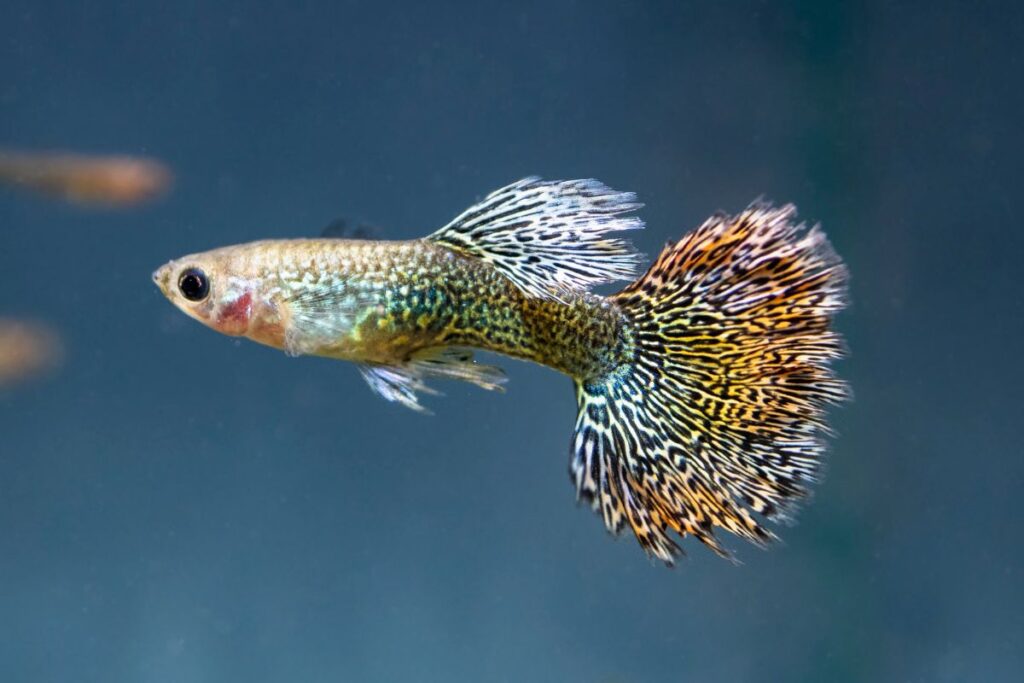
Table of Contents
Species Summary
Guppies are one of the most popular freshwater fish species in the aquarium trade. They are known for their vibrant colors, easy care, and lively personalities.
In this section, we will discuss the origin, appearance, size, growth rate, lifespan, behavior, and temperament of guppies.
Origin
Guppies are native to South America, specifically Venezuela, Trinidad, and Barbados.
They were first introduced to the aquarium trade in the early 20th century and have since become one of the most popular and widely distributed freshwater fish species in the world.
Appearance
Guppies are small, colorful fish with a variety of different tail and fin shapes.
They can have a wide range of colors, including red, blue, green, yellow, and orange, and can have spots or stripes on their bodies. The males are typically more colorful and have longer fins than the females.
Size
Guppies are small fish, typically growing to a maximum size of 1-2 inches in length. Females are usually slightly larger than males.
Growth Rate
Guppies are fast-growing fish and can reach their full size in just a few months under the right conditions.
They are also prolific breeders and can produce large numbers of offspring in a short amount of time.
Lifespan
Guppies have a relatively short lifespan, typically living for 2-3 years in captivity. However, with proper care and a healthy environment, they can live for up to 5 years.
Behavior & Temperament
Guppies are active and social fish that do well in groups. They are generally peaceful and can be kept with other small, non-aggressive fish.
However, males can sometimes be aggressive towards each other and may need to be separated if they become too territorial.
Personally, I have kept guppies in my aquarium for several years and have found them to be a delightful addition to my tank.
Their bright colors and playful personalities always bring a smile to my face, and I enjoy watching them swim and interact with each other.
Setting Up Your Tank
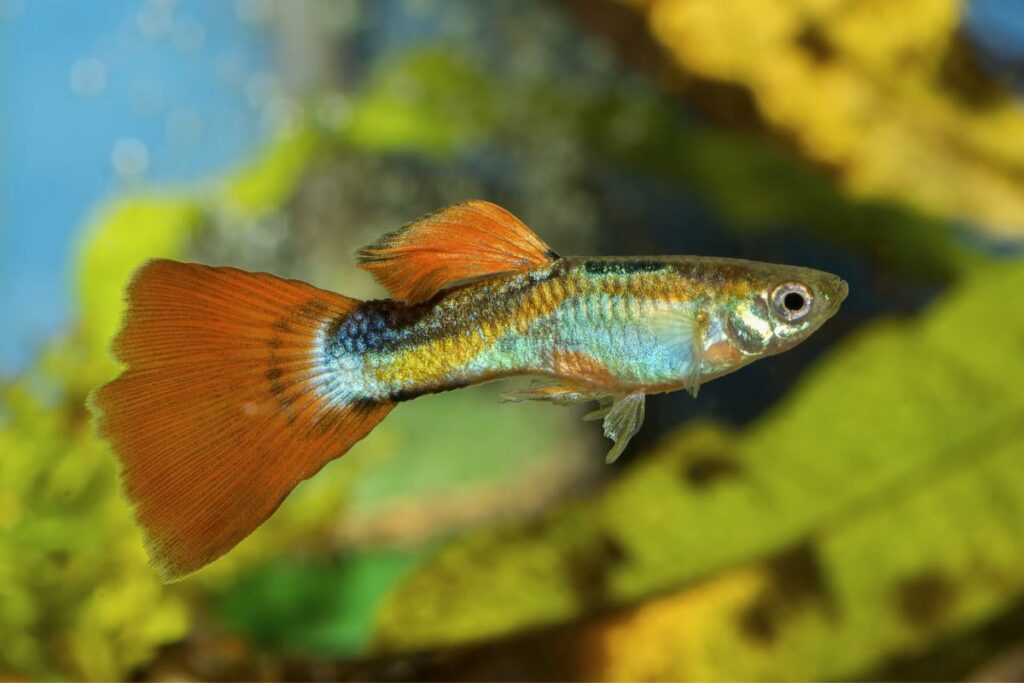
Setting up your tank is the first and most important step in ensuring your guppies thrive in their new home. Here are the key factors to consider:
Tank Size
The size of your tank is crucial to the health and well-being of your guppies. A general rule of thumb is to have at least one gallon of water per inch of fish.
For guppies, a 10-gallon tank is the minimum recommended size for a small group of fish.
However, if you plan to keep more than a few guppies, consider getting a larger tank to provide them with ample swimming space.
Filtration & Aeration
Filtration and aeration are essential to maintaining a healthy environment for your guppies.
A good filter will keep the water clean and remove harmful toxins, while an air pump will provide oxygen and keep the water moving.
Look for a filter that can handle at least twice the volume of your tank and an air pump with an appropriate size for your tank.
The best filter for guppy fish depends on the size of your aquarium and the specific needs of your guppies. However, in general, a hang-on-back (HOB) filter or a sponge filter is a good option for a guppy fish tank.
HOB filters are easy to install and provide excellent filtration for aquariums up to 50 gallons.
They are designed to hang on the back of the aquarium and circulate water through a filter cartridge that removes debris and harmful chemicals from the water.
HOB filters also provide good water circulation, which is important for guppy fish as they prefer a well-oxygenated environment.
Sponge filters are also a good option for guppy fish tanks, especially for smaller aquariums.
They are gentle and do not create strong currents, which is important for guppy fish as they prefer calm waters.
Sponge filters also provide a good surface area for beneficial bacteria to grow, which helps to maintain a healthy balance of the tank’s ecosystem.
Overall, it’s important to choose a filter that is appropriate for the size of your guppy fish tank, provides adequate filtration, and does not create strong currents that can harm your fish.
Additionally, it’s important to regularly clean and maintain your filter to ensure that it continues to function properly and keep your fish healthy.
Lighting
Guppies don’t require special lighting, but it’s important to provide a regular light cycle to mimic their natural environment. A standard aquarium light on a timer for 10-12 hours a day will suffice.
Heating
Guppies are tropical fish and require a consistent water temperature between 75-82°F. A good quality heater with a thermostat is essential to maintain the ideal temperature for your guppies.
Decoration
Decorating your tank not only makes it look more attractive but also provides hiding places for your guppies. Adding rocks, driftwood, and plants will create a natural-looking habitat for your fish.
Substrate
Choose a substrate that is gentle on your guppies’ delicate fins and doesn’t leach harmful chemicals into the water. Sand or fine gravel works well and provides a natural look for your tank.
Plants
Live plants not only add beauty to your tank but also provide natural filtration and oxygenation.
Java fern, anubias, and hornwort are all great choices for guppy tanks. However, if you don’t want to deal with the upkeep of live plants, silk plants are a good alternative.
When setting up your tank, keep in mind that every guppy is unique and may have different requirements.
It’s important to monitor your water parameters regularly and make adjustments as needed to ensure your guppies are happy and healthy.
Personally, I found that adding live plants not only made my tank look better, but it also helped reduce algae growth and kept my water parameters stable.
Plus, my guppies loved swimming through the plants and playing hide-and-seek!
Water Quality
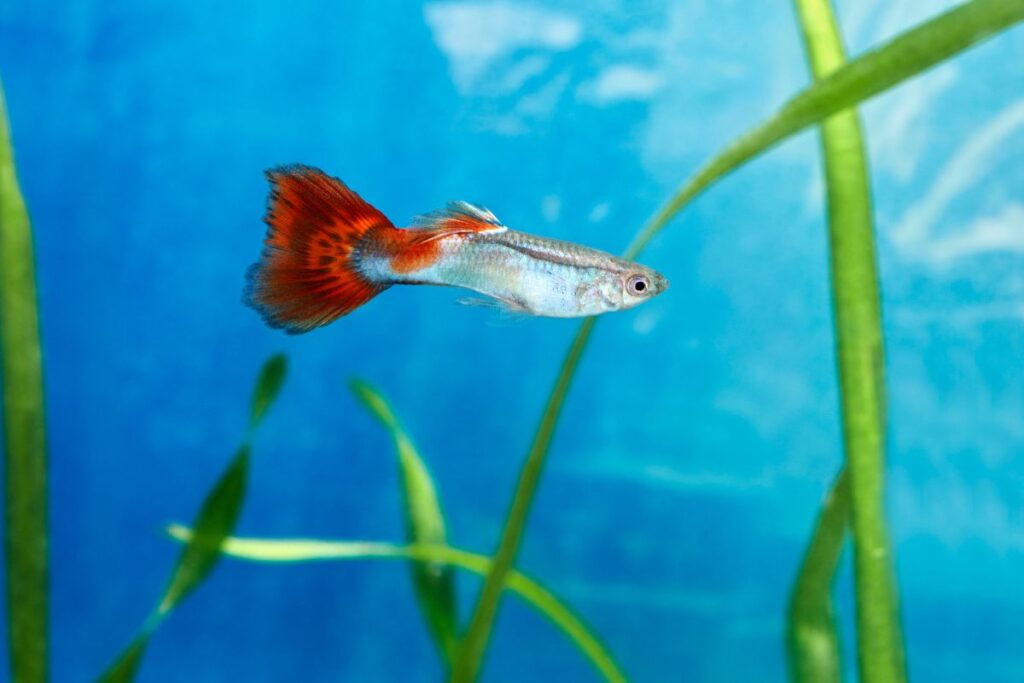
When it comes to guppy fish care, maintaining good water quality is crucial for their health and well-being. In this section, we will discuss the key factors that contribute to good water quality for your guppy fish.
Water Temperature
The ideal water temperature for guppy fish is between 75°F and 82°F. It’s important to maintain a consistent temperature within this range, as fluctuations can cause stress and illness in your fish.
I personally use a digital thermometer to monitor the water temperature in my aquarium, and adjust the heater as needed to keep it within the proper range.
Water pH
Guppy fish prefer a slightly alkaline pH level between 7.0 and 8.0. It’s important to regularly test the pH level of your aquarium water using a pH testing kit.
If the pH level is too low or too high, you can adjust it by adding pH-up or pH-down solutions. However, be careful not to make drastic changes to the pH level, as this can also cause stress and illness in your fish.
Water Hardness
Guppy fish prefer moderately hard water with a hardness level between 150 and 250 ppm. You can test the water hardness using a water hardness testing kit.
If the water is too soft or too hard, you can adjust it by adding a water conditioner or aquarium salt. However, be careful not to add too much, as this can also harm your fish.
Adding Chemicals
When adding chemicals to your aquarium, it’s important to follow the instructions carefully and not exceed the recommended dosage.
I always make sure to read the label and double-check the dosage before adding any chemicals to my aquarium.
Additionally, it’s important to avoid adding multiple chemicals at once, as this can cause chemical imbalances and harm your fish.
By maintaining good water quality, you can help ensure that your guppy fish live long and healthy lives.
Remember to regularly test the water temperature, pH level, and hardness, and make adjustments as needed to keep them within the proper range.
And always follow the instructions carefully when adding chemicals to your aquarium.
How Often to Change Water in Guppy Tank
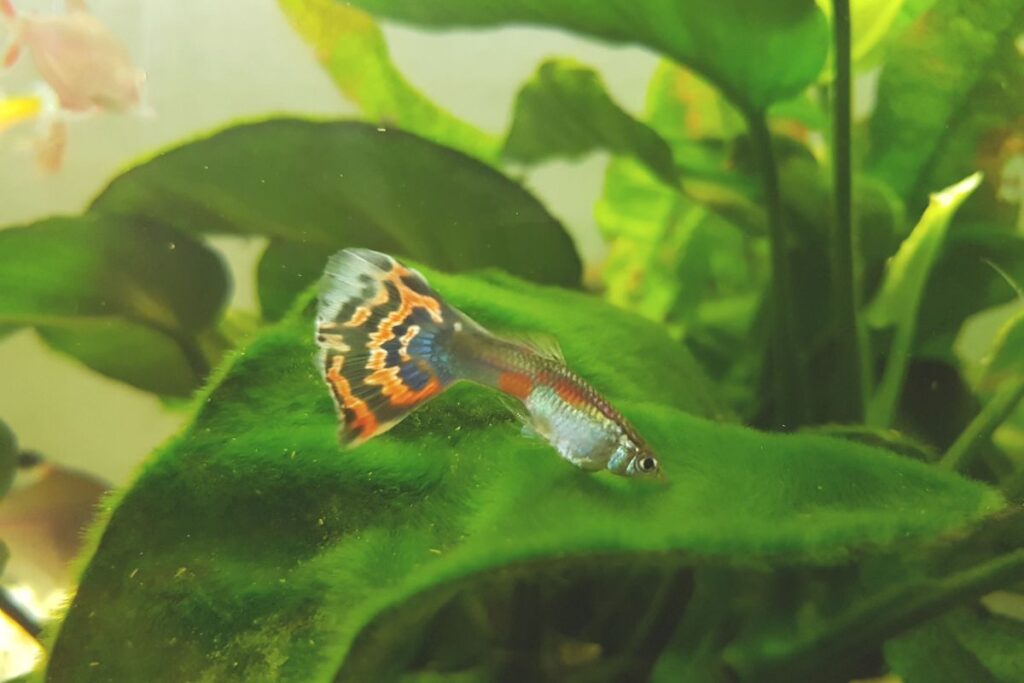
Regular water changes are essential to keep your guppy tank clean and healthy.
The frequency of water changes depends on various factors such as the size of the tank, the number of guppies, the filtration system, and the amount of food given to the fish.
As a general rule, it is recommended to change 10-20% of the water in your guppy tank every week.
Personally, I have a 10-gallon tank with five guppies, and I change 20% of the water every week. This routine has worked well for me, and my guppies are thriving.
However, you may need to adjust the frequency of water changes depending on your specific tank conditions.
It’s important to note that overfeeding your guppies can lead to a build-up of harmful waste in the tank, which can affect the water quality.
Therefore, it’s essential to feed your guppies only what they can consume in a few minutes and remove any uneaten food promptly.
If you notice any signs of poor water quality, such as cloudy water, foul odor, or sickly fish, you may need to increase the frequency of water changes.
In some cases, you may need to change up to 50% of the water or more to restore the water quality.
Overall, water changes are crucial to maintain a healthy and thriving guppy tank. By following a regular water change routine and monitoring your tank conditions, you can ensure that your guppies live in a clean and safe environment.
Feeding
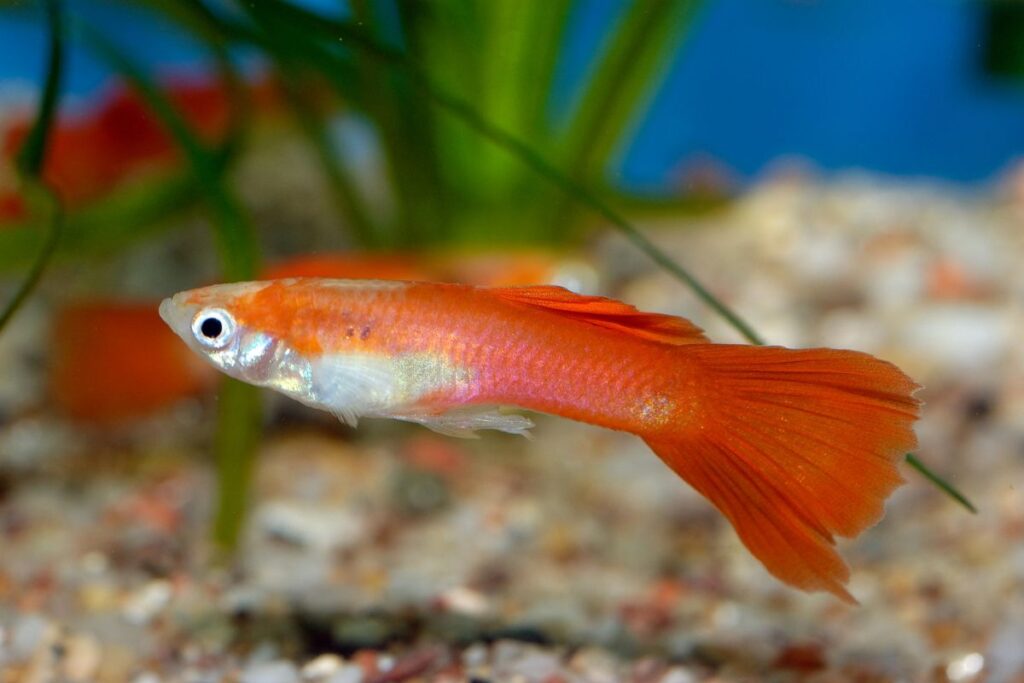
Feeding your guppy fish is an important aspect of their care. Proper nutrition is essential for their health and well-being.
In this section, we will discuss the types of food, feeding schedule, and feeding techniques for guppy fish.
Types of Food
Guppy fish are omnivores, which means they eat both plant and animal-based foods. The best food for guppy fish is a high-quality commercial fish food that is specifically formulated for them.
You can also supplement their diet with live or frozen foods such as brine shrimp, daphnia, and bloodworms. These foods provide essential nutrients that may not be present in dry fish food.
Feeding Schedule
Guppy fish should be fed small amounts of food two to three times a day. Overfeeding can lead to health problems such as obesity and constipation.
It is important to feed your guppy fish only what they can consume in a few minutes. If there is any uneaten food, remove it from the tank to prevent it from polluting the water.
Feeding Techniques
There are several feeding techniques that you can use to ensure your guppy fish are getting the proper nutrition. One technique is to scatter the food across the surface of the water.
This will encourage the guppy fish to swim to the surface and eat. Another technique is to use a feeding ring or target feeder. This will keep the food in one area of the tank, making it easier for the guppy fish to find and eat.
Personally, I like to use a combination of techniques when feeding my guppy fish. I scatter some food across the surface of the water and use a feeding ring for the rest.
This ensures that all of the guppy fish are getting enough food and that none of it goes to waste.
Overall, feeding your guppy fish is a simple task that can have a big impact on their health and well-being.
By providing them with a varied diet and using proper feeding techniques, you can ensure that your guppy fish are happy and healthy.
How Many Guppies Should Be Kept Together?
When it comes to keeping guppies, it’s important to consider the number of fish you plan to keep. Guppies are social creatures and thrive in groups, but overcrowding can lead to stress and health issues.
So, how many guppies should be kept together? As a general rule of thumb, you should aim to keep at least four guppies together. This allows for a healthy social dynamic and reduces the risk of aggression between individual fish.
However, it’s important to consider the size of your tank and the gender ratio of your guppies. In a 10-gallon tank, for example, you could comfortably keep up to six guppies.
However, if you have a larger tank, you could keep more. A 20-gallon tank could comfortably house up to 12 guppies. It’s also important to consider the gender ratio of your guppies.
Male guppies can be territorial and aggressive towards each other, so it’s best to keep a ratio of one male to two or three females.
This not only reduces aggression but also allows for a healthy breeding environment. Personally, I’ve found that keeping a small group of guppies together is not only visually appealing but also creates a lively and engaging aquarium environment.
Watching them interact and swim together is a true joy for any fish enthusiast. In summary, when it comes to keeping guppies, it’s important to consider the number of fish, the size of your tank, and the gender ratio.
By following these guidelines, you can create a healthy and engaging environment for your guppies to thrive in.
Guppy Tank Mates
If you’re considering adding guppies to your aquarium, it’s important to choose compatible tank mates that will get along with your guppies.
Guppies are peaceful fish, so it’s best to avoid aggressive or territorial fish that may harm them.
Personally, I have had success keeping guppies with other peaceful fish such as neon tetras, platies, and mollies. These fish have similar temperaments to guppies and can coexist peacefully in the same tank.
It’s important to note that some fish may view guppies as a tasty snack, so it’s best to avoid fish that are known to be predatory or have large mouths.
Additionally, it’s important to consider the size of the tank and the number of fish you plan to keep. Overcrowding can lead to stress and aggression among fish, so make sure to research the recommended stocking levels for your tank size.
Here are some other popular tank mates that can coexist peacefully with guppies:
- Cherry shrimp
- Otocinclus catfish
- Corydoras catfish
- Harlequin rasboras
- Zebra danios
Overall, choosing the right tank mates for your guppies is crucial for their health and happiness. By selecting peaceful fish that coexist well with guppies, you can create a harmonious and beautiful aquarium for all to enjoy.
Common Health Issues
As a guppy fish owner, it’s important to be aware of the common health issues that your fish may face. Here are some of the most common health issues that guppy fish experience:
Symptoms and Treatments
One common health issue that guppy fish face is fin rot. This is a bacterial infection that affects the fins and tail of the fish.
Symptoms of fin rot include frayed and discolored fins, as well as a loss of appetite. To treat fin rot, you can use antibiotics or salt baths. It’s important to also clean the tank and remove any dead or decaying matter.
Another common health issue is ich, which is a parasitic infection that causes small white spots on the fish’s body.
Other symptoms of ich include clamped fins and a loss of appetite. To treat ich, you can use medication or raise the temperature of the water to speed up the lifecycle of the parasite.
Prevention Tips
Prevention is key when it comes to keeping your guppy fish healthy. Here are some tips to help prevent common health issues:
- Keep the tank clean and well-maintained
- Avoid overfeeding your fish
- Quarantine new fish before introducing them to the tank
- Monitor the water temperature and pH levels
Personally, I once had a guppy fish that developed swim bladder disease. This caused the fish to swim upside down and struggle to stay upright.
I tried treating the fish with medication, but unfortunately, it didn’t survive. This experience taught me the importance of monitoring your fish’s health and acting quickly if you notice any symptoms.
How to Know if Your Guppy is Healthy
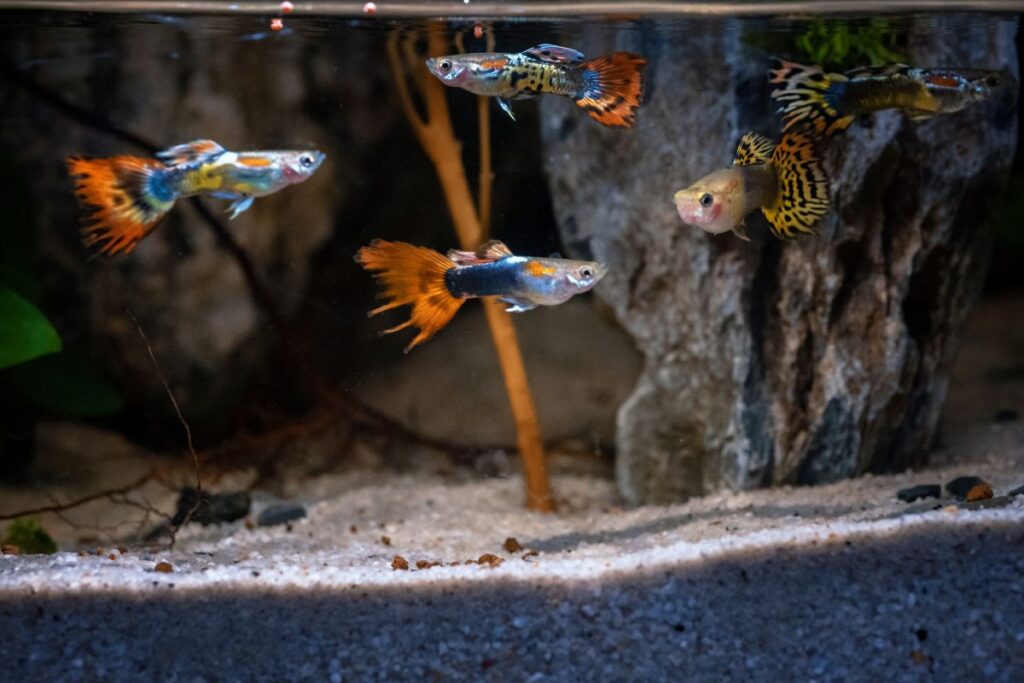
Guppies are hardy fish that can adapt to a variety of water conditions. However, like all living beings, they can get sick.
It’s important to know how to recognize the signs of a healthy guppy so you can take action if something is wrong.
One of the easiest ways to tell if your guppy is healthy is by looking at its color. A healthy guppy will have bright and vibrant colors.
If the color is faded or dull, it could be a sign of illness. Also, check for any discoloration, such as white spots or patches, which could be a sign of a fungal or bacterial infection.
Another way to tell if your guppy is healthy is by observing its behavior. A healthy guppy will be active and swim around the tank.
If it’s lethargic or sits at the bottom of the tank, it could be a sign of illness. Also, look for any signs of stress, such as rapid breathing or jumping out of the water.
Checking the fins is also important. A healthy guppy will have fins that are fully extended and not clamped. If the fins are clamped or torn, it could be a sign of illness or stress.
Also, check for any signs of fin rot, which can be identified by black or red discoloration on the edges of the fins.
Finally, pay attention to the guppy’s appetite. A healthy guppy will have a good appetite and eat regularly. If it’s not eating or has a decreased appetite, it could be a sign of illness.
Also, look for any signs of bloating or constipation, which could be a sign of digestive issues.
Personally, I had a guppy that I thought was healthy until I noticed it was sitting at the bottom of the tank and not swimming around like the others.
Upon closer inspection, I noticed that it had a fungal infection. I took action immediately and was able to save my guppy. That experience taught me the importance of monitoring my fish’s health regularly.
How to Know if Your Guppy is Sick
Guppies are generally hardy fish and can tolerate a wide range of water conditions. However, like any other living creature, they are susceptible to diseases and infections.
As a responsible pet owner, it is important to be aware of the signs of sickness in your guppies so that you can take appropriate action to treat them.
One of the most common signs of illness in guppies is a change in behavior. If your guppy is lethargic, not swimming as much as usual, or hiding in one spot, it could be a sign that something is wrong.
Additionally, if your guppy is not eating or has a decreased appetite, it could be a sign of illness.
Another sign of illness in guppies is physical changes. Look for any discoloration or spots on your guppy’s body, as well as any changes in its fins or tail.
If your guppy’s eyes are cloudy or bulging, it could be a sign of an infection.
If you notice any of these signs, it is important to act quickly to treat your guppy. You can consult with a veterinarian who specializes in fish care or research online to find appropriate treatments for your guppy’s specific illness.
Personally, I once had a guppy that was not swimming as much as usual and was hiding in the corner of the tank.
I immediately knew that something was wrong and did some research online to identify the problem.
It turned out that my guppy had a bacterial infection, and I was able to treat it with the appropriate medication. Within a few days, my guppy was back to its normal, active self.
Breeding
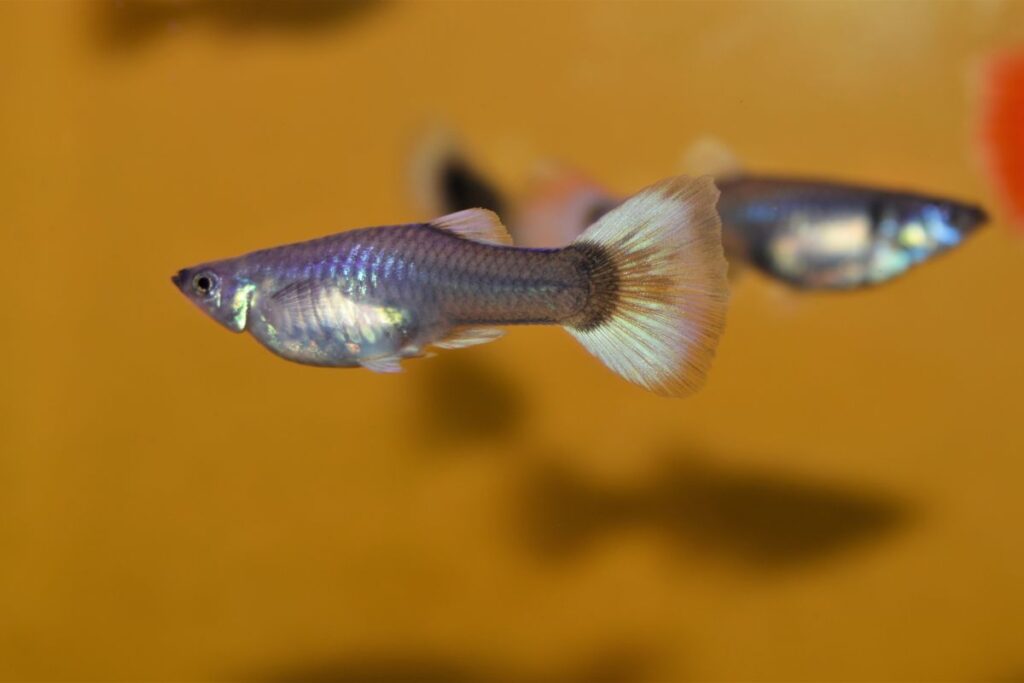
Breeding guppies can be a rewarding experience for any fish enthusiast.
However, it requires proper planning, preparation, and care. In this section, we’ll discuss the male to female ratio, breeding tank setup, and fry care.
Male to Female Ratio
When breeding guppies, it’s important to maintain a healthy male to female ratio. A ratio of one male to two females is ideal.
This helps to reduce stress on the females and minimizes the chances of aggression among males. Additionally, having more females increases the chances of successful breeding.
Breeding Tank Setup
Setting up a breeding tank is crucial for the success of breeding guppies. A breeding tank should be at least 10 gallons in size, with a heater and filter.
The temperature of the water should be between 75-82°F, and the pH level should be between 7.0-8.5.
To encourage breeding, add plants, such as java moss or hornwort, to the tank. These plants provide hiding places for the fry and also help to maintain good water quality.
Fry Care
Once the female guppy has given birth, it’s important to remove her from the breeding tank to prevent her from eating the fry.
The fry should be fed small amounts of powdered fish food, several times a day. It’s also important to maintain good water quality by performing regular water changes.
I remember my first time breeding guppies. I was so excited to see the tiny fry swimming around in the tank.
However, I quickly learned that fry care requires a lot of attention and effort. It’s important to be patient and diligent in caring for the fry to ensure their survival.
Breeding guppies can be a fun and rewarding experience. By maintaining a healthy male to female ratio, setting up a proper breeding tank, and providing proper care for the fry, you can successfully breed guppies and watch them grow into healthy adult fish.
Recommended Products:
- Aqueon QuietFlow LED PRO Aquarium Power Filter: This filter is suitable for tanks up to 20 gallons and has a 3-stage filtration system that keeps the water clean and removes harmful toxins. It also has an LED light that indicates when it’s time to change the filter cartridge.
- Tetra Whisper Air Pump: This air pump is suitable for tanks up to 40 gallons and provides oxygen and keeps the water moving. It’s quiet and energy-efficient, making it a great choice for guppy tanks.
- Hygger 50W Titanium Aquarium Heater: This heater is suitable for tanks up to 10 gallons and has a thermostat that maintains a consistent water temperature between 75-82°F. It’s made of titanium, which is durable and corrosion-resistant.
- CaribSea Super Naturals Aquarium Sand: This sand substrate is gentle on guppies’ delicate fins and provides a natural look for your tank. It’s also pH neutral and doesn’t leach harmful chemicals into the water.
- API Freshwater Master Test Kit: This test kit allows you to monitor the water temperature, pH level, and hardness, and make adjustments as needed to keep them within the proper range. It’s essential for maintaining good water quality for your guppies.
- Fluval Plant and Shrimp Stratum: This substrate is specifically designed for planted aquariums and provides a nutrient-rich substrate that promotes healthy plant growth. It’s also pH neutral and doesn’t leach harmful chemicals into the water.
- NICREW ClassicLED Aquarium Light: This LED light provides a regular light cycle to mimic the guppies’ natural environment. It’s energy-efficient and has adjustable brightness levels, making it a great choice for guppy tanks.
- Hikari Bio-Pure Freeze Dried Blood Worms: These freeze-dried bloodworms are a great source of protein for guppy fish. They’re easy to feed and can be used as a supplement to their regular diet.
Conclusion
After researching and writing this guppy fish care guide, I have gained a newfound appreciation for these colorful and lively fish. Not only are they easy to care for, but they also bring a lot of joy and entertainment to any aquarium.
Remember to provide a clean and healthy environment for your guppies, with a well-maintained tank and proper water conditions. Feeding them a balanced diet and keeping an eye out for any signs of illness or disease is also crucial for their well-being.
Overall, guppies are a great choice for beginner and experienced fish keepers alike. With their vibrant colors, playful personalities, and low-maintenance care requirements, they are sure to make a wonderful addition to any aquarium.
So go ahead and add some guppies to your tank – you won’t be disappointed!
FAQs
As a guppy fish owner, you may have some questions about their care. Here are some frequently asked questions:
Q: How often should I feed my guppy fish?
A: It is recommended to feed your guppy fish twice a day with small amounts of food. Overfeeding can lead to health problems and water quality issues.
Q: What temperature should the water be for guppy fish?
A: Guppy fish thrive in water temperatures between 75-82°F (24-28°C). Make sure to monitor the temperature regularly and adjust as needed.
Q: Can I keep male and female guppy fish together?
A: Yes, male and female guppy fish can coexist peacefully. However, keep in mind that guppy fish breed rapidly and can quickly overpopulate a tank. Consider having more females than males to balance the population.
Q: How often should I clean the tank?
A: It is recommended to do a partial water change of 25% every 2-4 weeks and clean the tank once a month. Regular maintenance is important to keep the water quality high and prevent health issues for your guppy fish.
Q: Can guppy fish live with other fish species?
A: Yes, guppy fish are social and can live with other peaceful fish species. However, avoid keeping them with aggressive or larger fish that may harm them.
Personally, I had a guppy fish that was very active and loved to interact with me during feeding time. It was a joy to watch it swim around the tank and play with its tank mates. By following the proper care guidelines and addressing any issues promptly, you can enjoy the company of your guppy fish for years to come.
Reference: Wikipedia
